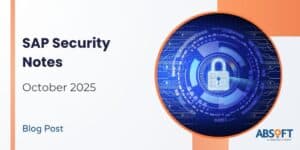Are you on course for SuccessFactors Employee Central (EC) Payroll? Then you probably know that preparing processes and data should start well before the implementation project.
Using a system for 20 years (or more) creates stability and comfort. Conversely, it accumulates old gremlins in the data and the skeletons of past workarounds in the configuration. Keeping what’s good is essential. Scrapping what’s bad, however, is near enough impossible if you don’t have the right tools and expertise. This blog gives an overview on tackling legacy SAP HCM data and systems ahead of migration.
This article will cover:
- The context for migration
- SuccessFactors EC Payroll’s value proposition
- The complexities of data migration
- Preparing your systems and data for migration
Â
Don’t hesitate to get in touch if you require any help or have a question.Â
Where are you coming from?
This information is for customers currently carrying the SAP HCM Payroll module in SAP ERP 6.0 or S/4HANA. Concordantly, HR business transformations and ‘RISE with SAP’ projects might have a SuccessFactors integration. Another reason could be the end of ERP 6.0 maintenance in 2027.
The preparation of data for migration will be predicated if one presently uses a non-SAP payroll administration system. Such a project, however, will look slightly different than what’s described here. Absoft can help with non-SAP data migration by leveraging our wealth of experience in similar projects.
What’s different in SuccessFactors EC Payroll?
Those who have already implemented SAP HCM Payroll are in luck; it’s based on the same familiar payroll engine, so you can benefit from the new software without relearning the basic concepts of wage types and payroll schemas.
Customisation options are different as EC Payroll has a higher level of standardisation than SAP HCM, which enables automatic legislative updates and more frequent improvements, albeit without lengthy patching projects or downtime.
In more good news, changes to the payroll schema are still possible. You can still build payroll functions and reports as well as building schemas and rules. The new restriction, however, is that you cannot make modifications to SAP-standard code or use enhancement spots.
Is the move from SAP HCM to SuccessFactors EC Payroll a simple data migration?
It’s immediately tempting to lift and shift current data into SuccessFactors EC Payroll, but that path is fraught with danger and missed opportunity. You can’t streamline or improve processes without making any changes, and you can’t make changes if the integration is not understood and simplified.
Most significantly, some customisations used for past legislative compliance may not be possible in the new system. It is essential that you identify if you have a dependency on customised enhancements and/or modifications for legislative compliance that are no longer available.
You need total visibility to forge a clear, safe path
Before data preparation or cleansing can begin, you must understand:
- What data, objects, and configurations are in use
- Whether the current systems are compliant with legislation, and what parts aren’t
- How to achieve the correct payroll processing and through which modifications, customisations, and configuration
Â
Even with an understanding of the current system, recommending or executing any simplification requires a total understanding of the technology, legislative compliance, industry-specific aspects, and payroll processing. Not a small order!
How should a migration into SuccessFactors EC Payroll be done?
At Absoft, we’ve developed a collection of tools to assess and understand an existing SAP HCM implementation, make recommendations, and execute clean-up and preparation of payroll data before migration even begins.
Absoft’s Payroll Data Tools include:
- Wage Types Where-Used and Last-Used: This report allows us to see the real usage of wage types today and in the recent past to enable safe archiving or deleting unused wage types. Test efforts are reduced as a benefit, along with the complexity of the migrated payroll.
- Wage Type Legislative Compliance: Our assessment confirms the current legislative compliance of wage types, and how that compliance is achieved, to ensure correct behaviour today and after migration.
- Enhanced RTI New Pay Checks: Ensures the correct data is submitted to HMRC, including reconciliation before, during, and after migration.
Â
Our data tools allow us to help customers understand and safely simplify their existing configuration and objects, eliminating the baggage of a mature system. There is no value in – and indeed a significant risk with – migrating a wage type that isn’t compliant with today’s legislation or one that outright isn’t used.
Technical Checks
You can’t stop at only data. Often, it’s not clear exactly how the system achieves compliance or what migrating to a standardised cloud-based system would lose. It’s a common misconception that having a mature system is an argument not to migrate. A seemingly stable, hard-won, and low-risk system may allude a series of finely balanced yet poorly understood modifications.
We deploy our Payroll-specific ABAP workbench audit reports to assess all modifications to objects utilised within payroll. We categorise these modifications into those that will be possible in EC Payroll, and those that won’t. The wider payroll configuration cannot be fully understood otherwise.
Specialist skillset for recommendations and execution
The output of all the above is simple: prioritised data cleansing and system maintenance activities to take place before, during, and after migration from SAP HCM Payroll to SuccessFactors EC Payroll. Each is documented with implications, risks, benefits, and documented levels of effort for safe execution.
There’s really no way to fake or automate what’s needed to completely audit, review, make recommendations, and execute changes to a mature payroll administration system. Rather, it needs technical experience in SAP on-premises customisations, a functional understanding of SAP HCM, and industry-specific payroll knowledge.
This execution necessitates experience in SAP HCM, not only SuccessFactors, to make changes or prepare data for migration. As a skillset in increasingly short supply, many projects face problems due to a lack of understanding of the legacy systems.
The time to start is now!
The clock is ticking. Change is happening faster than ever before in the SAP space, and those who have not already integrated SuccessFactors EC Payroll into their HR management system likely will soon. Safely analysing, preparing, and migrating will take time. Starting the preparation early, in the legacy system, will reduce risk and increase benefits from standardisation and streamlined integration processes.
To learn more about our team’s experience, tools, and capabilities, please reach out to us now!










